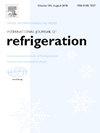Evaluation of different subcooling arrangements in a CO2 refrigeration plant using extractions from the flash-gas tank
IF 3.5
2区 工程技术
Q1 ENGINEERING, MECHANICAL
International Journal of Refrigeration-revue Internationale Du Froid
Pub Date : 2025-04-21
DOI:10.1016/j.ijrefrig.2025.03.037
引用次数: 0
Abstract
Carbon dioxide (CO2) is a widely used natural refrigerant with a low critical temperature (∼31 °C), that makes necessary the use of complex cycle arrangements to enhance the performance of refrigerating plants, especially at high ambient temperatures. Considering this, the present work evaluates two simple subcooling arrangements experimentally based on stream extractions from the flash-gas tank installed between the back-pressure valve and the thermostatic expansion valve. These extractions are expanded in a subcooler installed at the exit of the gas-cooler, providing the subcooling effect depending on the tank pressure and the fluid extracted (liquid or vapour). Since the flash-gas tank pressure introduces a new degree of freedom, an optimisation process for maximising the COP is mandatory depending on the heat-rejection conditions (temperature and pressure). Therefore, this work presents the optimisation process for three heat-rejection temperatures (28, 31 and 34 °C) using extractions from vapour or liquid, reaching COP improvements up to 9.4 % with optimal pressure reductions of up to 3.0 bar.
利用闪焰气罐萃取物对CO2制冷装置中不同过冷装置的评价
二氧化碳(CO2)是一种广泛使用的天然制冷剂,具有较低的临界温度(~ 31°C),这使得有必要使用复杂的循环安排来提高制冷设备的性能,特别是在高环境温度下。考虑到这一点,本工作基于安装在背压阀和恒温膨胀阀之间的闪气罐的流提取,对两种简单的过冷布置进行了实验评估。这些提取液在安装在气体冷却器出口处的过冷器中进行膨胀,根据储罐压力和提取的流体(液体或蒸汽)提供过冷效果。由于闪气罐压力引入了新的自由度,因此必须根据散热条件(温度和压力)优化COP最大化过程。因此,这项工作提出了三种散热温度(28,31和34°C)的优化过程,使用从蒸汽或液体中提取,达到COP改善高达9.4%,最佳压力降低高达3.0 bar。
本文章由计算机程序翻译,如有差异,请以英文原文为准。
求助全文
约1分钟内获得全文
求助全文
来源期刊
CiteScore
7.30
自引率
12.80%
发文量
363
审稿时长
3.7 months
期刊介绍:
The International Journal of Refrigeration is published for the International Institute of Refrigeration (IIR) by Elsevier. It is essential reading for all those wishing to keep abreast of research and industrial news in refrigeration, air conditioning and associated fields. This is particularly important in these times of rapid introduction of alternative refrigerants and the emergence of new technology. The journal has published special issues on alternative refrigerants and novel topics in the field of boiling, condensation, heat pumps, food refrigeration, carbon dioxide, ammonia, hydrocarbons, magnetic refrigeration at room temperature, sorptive cooling, phase change materials and slurries, ejector technology, compressors, and solar cooling.
As well as original research papers the International Journal of Refrigeration also includes review articles, papers presented at IIR conferences, short reports and letters describing preliminary results and experimental details, and letters to the Editor on recent areas of discussion and controversy. Other features include forthcoming events, conference reports and book reviews.
Papers are published in either English or French with the IIR news section in both languages.

 求助内容:
求助内容: 应助结果提醒方式:
应助结果提醒方式:


